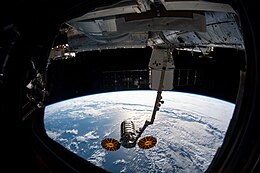 Canadarm2 grapples the S.S. Roger Chaffee, while Dragon C108 is docked to Harmony. | |
| Names | CRS NG-11 CRS OA-11 (2016–2018) |
|---|---|
| Mission type | ISS resupply |
| Operator | Northrop Grumman |
| COSPAR ID | 2019-022A |
| SATCAT no. | 44188 |
| Mission duration | 232 days, 18 hours, 42 minutes |
| Spacecraft properties | |
| Spacecraft | S.S. Roger Chaffee |
| Spacecraft type | Enhanced Cygnus |
| Manufacturer |
|
| Start of mission | |
| Launch date | 17 April 2019, 20:46:07 UTC (4:46:07 pm EDT)[1] |
| Rocket | Antares 230 |
| Launch site | MARS, Pad 0A |
| End of mission | |
| Disposal | Deorbited |
| Decay date | 6 December 2019, 15:28 UTC |
| Orbital parameters | |
| Reference system | Geocentric orbit |
| Regime | Low Earth orbit |
| Inclination | 51.66° |
| Berthing at ISS | |
| Berthing port | Unity nadir |
| RMS capture | 19 April 2019, 09:28 UTC[1] |
| Berthing date | 19 April 2019, 11:31 UTC |
| Unberthing date | 6 August 2019, 13:30 UTC[2] |
| RMS release | 6 August 2019, 16:15 UTC[3] |
| Time berthed | 109 days, 1 hour, 59 minutes |
| Cargo | |
| Mass | 3,436 kg (7,575 lb)[4] |
| Pressurised | 3,162 kg (6,971 lb) |
| Unpressurised | 239 kg (527 lb) |
 NASA insignia | |
NG-11, previously known as OA-11, is the twelfth flight of the Northrop Grumman robotic resupply spacecraft Cygnus and its eleventh flight to the International Space Station under the Commercial Resupply Services (CRS-1) contract with NASA.[5][6] The mission launched on 17 April 2019 at 20:46:07 UTC.[1] This is the last mission from the extended CRS-1 (phase 1) contract; follow-up missions are part of the CRS-2 contract.[7] Cygnus NG-11 was also the first mission to load critical hardware onto Cygnus within the last 24 hours prior to launch, a new Antares feature.[8]
Orbital ATK and NASA jointly developed a new space transportation system to provide commercial cargo resupply services to the International Space Station (ISS). Under the Commercial Orbital Transportation System (COTS) program, then Orbital Sciences designed and built Antares, a medium-class launch vehicle; Cygnus, an advanced maneuvering spacecraft, and a Pressurized Cargo Module which is provided by Orbital's industrial partner Thales Alenia Space.[9] Northrop Grumman purchased Orbital in June 2018; its ATK division was renamed Northrop Grumman Innovation Systems.[10]
Concurrently, Nepalese satellite NepaliSat-1 and Sri Lankan satellite Raavana 1 were launched as part of Cygnus NG-11 as deployable payloads.[11]

- ^ a b c Richardson, Derek (19 April 2019). "NG-11 Cygnus Begins 3-month ISS Stay". Spaceflight Insider. Retrieved 4 November 2019.
- ^ Todd, David (12 August 2019). "Cygnus NG-11 departs ISS dropping off satellites as it goes". Seradata. Retrieved 4 November 2019.
- ^ Clark, Stephen (6 August 2019). "Cygnus supply ship departs space station, begins extended mission". Spaceflight Now. Retrieved 4 November 2019.
- ^ Cite error: The named reference
nasa-crs11-overviewwas invoked but never defined (see the help page). - ^ Cite error: The named reference
sfn-launchtrackerwas invoked but never defined (see the help page). - ^ Cite error: The named reference
seds-issschedulewas invoked but never defined (see the help page). - ^ Gebhardt, Chris (1 June 2018). "Orbital ATK looks ahead to CRS2 Cygnus flights, Antares on the commercial market". NASASpaceFlight.com. Retrieved 2 June 2018.
- ^ Foust, Jeff (16 April 2019). "Latest Cygnus mission to ISS includes new features". SpaceNews. Retrieved 23 September 2019.
- ^ Cite error: The named reference
orbatkbr-fs00608oa3891was invoked but never defined (see the help page). - ^ Erwin, Sandra (5 June 2018). "Acquisition of Orbital ATK approved, company renamed Northrop Grumman Innovation Systems". SpaceNews. Retrieved 23 July 2018.
- ^ Paudel, Nayak (18 April 2019). "Nepal's first ever satellite launched into space". The Kathmandu Post. Retrieved 18 April 2019.